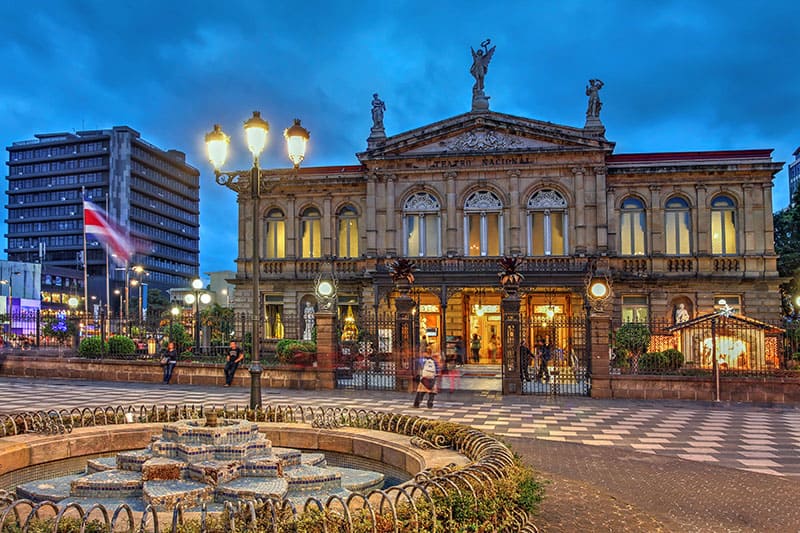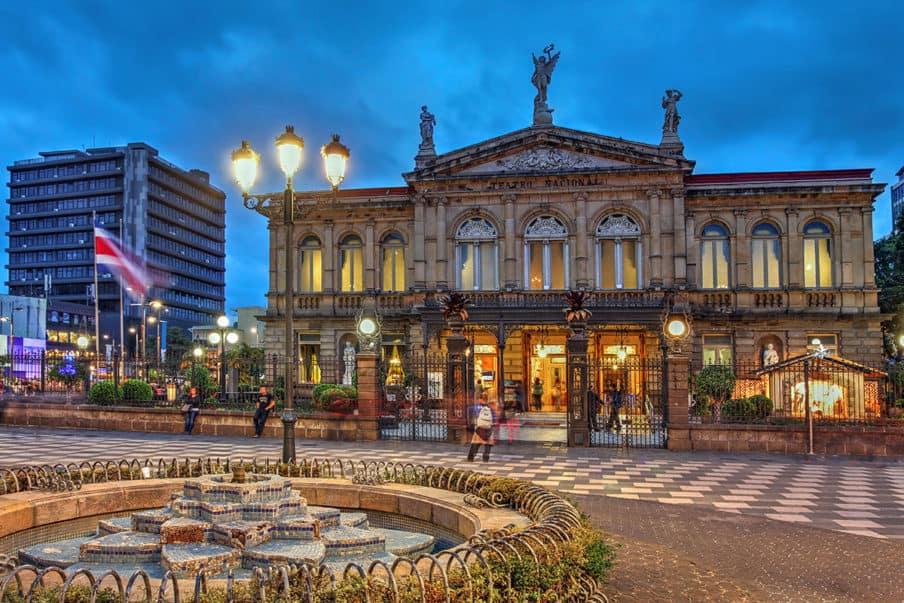
The National Theatre of Costa Rica, located in San José, is a key cultural landmark and a symbol of the country’s artistic heritage. Opened in 1897, this theater is known for its neo-classical architecture, inspired by the Palais Garnier in Paris, and is one of the most notable buildings in Central America.
It serves as a venue for performances and a point of interest for visitors exploring Costa Rica’s history and arts. This post covers the theater’s history, architecture, performances, and practical details for planning a visit.
History of the Theatre
In the late 19th century, Costa Rica’s coffee industry was thriving, and San José’s leaders aimed to establish the city as a cultural hub. With a population of about 19,000, the city took on the ambitious project of building a theater to attract international opera troupes.
The National Theatre was funded through a tax on coffee exports, reflecting the crop’s economic importance. Construction began in 1891, led by Belgian architect Lucien Rougier and Italian architect Cristoforo Molinari, with an Italian engineer addressing early structural issues.
The theater opened on October 21, 1897, with a performance of Johann Wolfgang von Goethe’s Faust. It replaced the simpler Teatro Mora, which had served San José until an earthquake destroyed it. The National Theatre became the city’s primary venue for opera and other performances, drawing both local elites and visiting artists. Designated a National Monument in 1965 and a Symbol of Historical Architectural Heritage and Cultural Freedom in 2018, the theater remains a central part of Costa Rican identity.
Architecture and Design

The National Theatre’s exterior features a neo-classical design with columns and detailed carvings, influenced by European architecture, particularly the Paris Opera House. Statues of Spanish playwright Calderón de la Barca and composer Ludwig van Beethoven stand at the entrance, with additional monuments, including one of Frédéric Chopin, along the walkway.
The interior includes a foyer with Carrara marble flooring, bronze accents, and 22.5-carat gold leaf trim. Chandeliers light the space, and statues by Italian sculptor Pietro Bulgarelli, representing Dance, Music, and Fame, line the entry. The main auditorium, seating about 1,040, has red velvet chairs and acoustics designed for performances.
A notable feature is the ceiling mural, Allegory of Coffee and Bananas, painted by Italian artist Aleardo Villa. This artwork, once depicted on Costa Rica’s five-colón bill, shows coffee and banana harvests, though Villa, who never visited Costa Rica, included inaccuracies, such as farmers holding bananas in their arms instead of over their shoulders. The theater’s floor can lower for performances or rise to stage level for events, a design innovation from the 19th century.
Performances and Cultural Role
The National Theatre hosts the National Symphony Orchestra, National Ballet, and National Children’s Choir, along with operas, plays, ballets, and concerts by local and international artists. Recent shows include The Nutcracker, the ballet In the Branches of the Cypress, and piano festivals. Free performances are offered at lunchtime and on Thursdays at 5:00 PM, making the theater accessible to a wide audience.
The theater supports Costa Rican culture by promoting new artists, hosting workshops, and displaying art exhibitions in the foyer. It has undergone renovations to maintain its structure after earthquakes, ensuring its continued use. For many Costa Ricans, the theater represents a commitment to the arts and community engagement, serving as a venue for both entertainment and education.
Visitor Information
The National Theatre is located at Avenida 2, between Calles 3 and 5, in San José’s Catedral district, accessible by foot, taxi, or public transport. No parking is available on-site, but nearby lots offer shuttles for performance attendees. The theater is open Monday to Sunday from 9:00 AM to 5:00 PM, with guided tours in English and Spanish offered hourly from 9:00 AM to 4:00 PM. Tours cost approximately ₡3,500 (about $7 USD) for foreign adults, with free entry for children under 12.
Tours provide details on the theater’s history and architecture, often led by guides who may dress as historical figures for an interactive experience. Visitors may observe rehearsals or free performances during tours. The Café Allegro in the foyer serves Costa Rican coffee and light meals, and a gift shop sells souvenirs.
Tickets for performances can be purchased online via the theater’s website, at the box office, or through authorized vendors, with prices varying by event. Recent Tripadvisor reviews highlight the theater’s architecture and the quality of guided tours, recommending them for their historical insights.
| Visitor Information | Details |
|---|---|
| Location | Avenida 2, Calles 3-5, San José, Costa Rica |
| Hours | 9:00 AM – 5:00 PM, Monday to Sunday |
| Guided Tours | Hourly, 9:00 AM – 4:00 PM; ₡3,500 for foreign adults, free for kids under 12 |
| Tickets for Shows | Available online, at box office, or via authorized vendors; prices vary |
| Free Performances | Lunchtime and Thursdays at 5:00 PM |
| Accessibility | Limited; contact theater for accommodations |
| Parking | No direct parking; nearby lots with shuttle for performances |
| Amenities | Café Allegro, gift shop, art exhibitions |
Reasons to Visit
The National Theatre of Costa Rica offers a direct connection to the country’s history and culture. Its architecture reflects European influences adapted to a Costa Rican context, while its performances showcase both local and global talent.
The theater’s role in education and community engagement highlights its importance beyond entertainment. Visitors can explore the building through guided tours, enjoy a coffee at Café Allegro, or attend a performance to experience Costa Rica’s artistic scene. If you’re in San José, the National Theatre is worth a visit for its historical and cultural significance.

